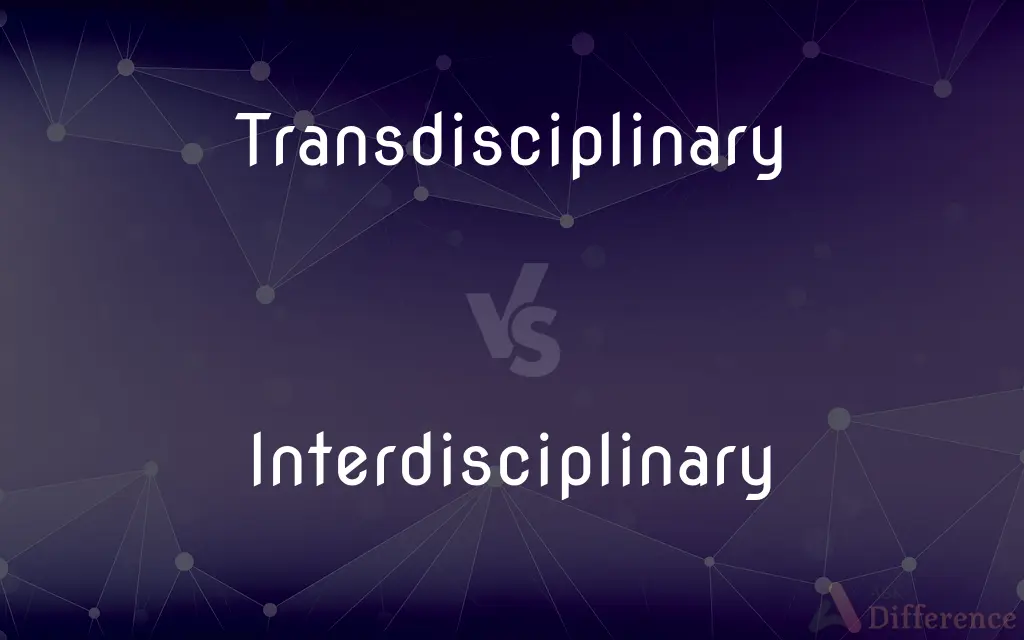Transdisciplinary vs. Interdisciplinary — What's the Difference?
By Urooj Arif & Fiza Rafique — Updated on May 3, 2024
Transdisciplinary approaches integrate knowledge beyond disciplinary boundaries to create new frameworks, while interdisciplinary methods synthesize insights from multiple disciplines within existing frameworks.

Difference Between Transdisciplinary and Interdisciplinary
Table of Contents
ADVERTISEMENT
Key Differences
Transdisciplinary research involves creating new conceptual, theoretical, and methodological frameworks that go beyond the scope of disciplinary boundaries. Whereas, interdisciplinary research synthesizes and integrates perspectives from various disciplines but operates within their existing frameworks.
In a transdisciplinary approach, experts from different fields work collaboratively to develop new understandings and solutions that are not confined to the boundaries of their disciplines. On the other hand, interdisciplinary approaches combine knowledge to address a common problem without necessarily creating new theoretical structures.
Transdisciplinary studies often aim at solving complex real-world problems that cannot be understood through a single disciplinary lens. Interdisciplinary studies, while also aimed at complexity, rely on existing disciplinary tools and theories to address problems.
A transdisciplinary method typically results in outcomes that might include new teaching methods, policies, or ways of organizing social services that transcend traditional disciplinary limits. Conversely, interdisciplinary outcomes often enhance existing disciplines through the integration of diverse methodologies and viewpoints.
While both approaches are valuable in addressing complex issues, transdisciplinary work often requires a rethinking of foundational assumptions and practices, leading to more innovation and reform in various fields. Interdisciplinary work, however, tends to focus more on collaboration and synthesis without necessarily challenging existing disciplinary boundaries.
ADVERTISEMENT
Comparison Chart
Definition
Involves integrating knowledge and methods from different disciplines, creating new frameworks.
Integrates knowledge and methods from different disciplines within existing frameworks.
Goal
To address complex issues by transcending and redefining disciplinary boundaries.
To analyze, synthesize, and harmonize links between disciplines in pursuit of a common goal.
Methodology
Creation of new theoretical frameworks that are not confined to existing disciplinary boundaries.
Utilization of existing theoretical frameworks to approach a problem from multiple disciplines.
Problem Solving
Focused on creating solutions that fundamentally change how problems are approached and understood.
Focused on collaborative solutions that enhance understanding within traditional boundaries.
Outcome
Often results in innovative practices, new types of knowledge, and solutions that reformulate existing norms.
Typically enhances and expands existing disciplinary techniques and understanding.
Compare with Definitions
Transdisciplinary
Involving collaborations that seek to create unity of intellectual frameworks beyond the disciplinary perspectives.
The conference on climate change promoted a transdisciplinary approach to developing sustainable technologies.
Interdisciplinary
Pertaining to combining and integrating knowledge from different academic disciplines in a coordinated way.
The interdisciplinary research focused on the intersection of psychology and artificial intelligence.
Transdisciplinary
Characterized by methods that transcend traditional boundaries of disciplines to address global challenges.
Their transdisciplinary work led to breakthroughs in renewable energy systems.
Interdisciplinary
Involves working across traditional boundaries to address a common research goal.
Their interdisciplinary teamwork improved techniques in remote sensing applications.
Transdisciplinary
Denotes efforts that integrate multiple disciplines along with stakeholders to innovate or solve issues.
The transdisciplinary team worked to implement new health protocols that were informed by medical research and cultural practices.
Interdisciplinary
Characterized by collaboration among scholars from various disciplines to enhance research outcomes.
The interdisciplinary project between biologists and chemists led to innovative drug discovery.
Transdisciplinary
Involves the fusion of professional knowledge across disciplines to develop novel solutions.
Transdisciplinary approaches in education reform have introduced new pedagogical theories.
Interdisciplinary
Pertains to studies that combine elements from different disciplines to foster deeper understanding in research.
Interdisciplinary studies in urban development have combined insights from economics, sociology, and city planning.
Transdisciplinary
Pertaining to research efforts that integrate academic disciplines as well as non-academic knowledge to explore complex problems.
The transdisciplinary project combined economics, sociology, and urban planning with local community insights.
Interdisciplinary
Involves the integration of methodologies, tools, and conceptual frameworks from two or more disciplines.
Their interdisciplinary approach created a new lens to study historical events through both literary and archaeological evidence.
Transdisciplinary
Holistically encompassing more than one academic discipline.
Interdisciplinary
Of, relating to, or involving two or more academic disciplines that are usually considered distinct.
Interdisciplinary
Of or pertaining to multiple distinct academic disciplines or fields of study.
This journal is interdisciplinary: it has articles on everything from biology to electrical engineering.
Interdisciplinary
Of or pertaining to a linkage between multiple distinct academic disciplines or fields of study.
The interdisciplinary co-operation at this university is very impressive.
Interdisciplinary
Drawing from or characterized by participation of two or more fields of study;
Interdisciplinary studies
An interdisciplinary conference
Common Curiosities
How do interdisciplinary and transdisciplinary approaches impact education?
They encourage more integrated and holistic learning experiences that can be more relevant to solving real-world problems.
What are the challenges of conducting transdisciplinary research?
It often involves navigating differing terminologies, methodologies, and expectations from various fields.
Is transdisciplinary research more challenging than interdisciplinary?
Typically, yes, as it requires creating new conceptual frameworks and not just merging existing ones.
What does successful interdisciplinary collaboration require?
Effective communication, mutual respect among different disciplinary experts, and a clear common goal are key.
What distinguishes a transdisciplinary approach from an interdisciplinary one?
Transdisciplinary approaches integrate and transcend disciplines to create new frameworks, while interdisciplinary combines within existing ones.
Why is transdisciplinary research important in today's world?
It addresses complex societal issues by integrating diverse perspectives and knowledge beyond academic disciplines.
What skills are crucial for successful transdisciplinary research?
Strong collaboration, open-mindedness, and a willingness to explore and integrate across traditional academic boundaries are essential.
Why might a researcher choose an interdisciplinary approach over a transdisciplinary one?
If the goal is to enhance existing disciplinary knowledge rather than create new frameworks, interdisciplinary might be preferred.
Can interdisciplinary research evolve into transdisciplinary?
Yes, interdisciplinary collaboration can lead to transdisciplinary innovation if it challenges and redefines the foundational boundaries of the disciplines involved.
How do funding agencies view transdisciplinary research?
Increasingly, funding agencies support transdisciplinary research due to its potential for groundbreaking solutions and innovations.
Can transdisciplinary approaches be applied in industry settings?
Yes, industries that deal with complex systems and innovation often employ transdisciplinary methods.
What kind of problems are best suited for transdisciplinary approaches?
Complex, multifaceted problems like climate change, public health crises, and urban development benefit from transdisciplinary approaches.
How do outcomes of transdisciplinary research differ from those of interdisciplinary research?
Transdisciplinary outcomes often innovate or create new ways of thinking, while interdisciplinary outcomes typically expand on existing knowledge.
How do academic institutions support transdisciplinary research?
Many institutions now offer programs and centers dedicated to fostering transdisciplinary and interdisciplinary research.
Can non-academics participate in transdisciplinary research?
Yes, transdisciplinary research often involves various stakeholders, including community members and practitioners, to incorporate broader perspectives.
Share Your Discovery

Previous Comparison
Diorite vs. Granite
Next Comparison
Geoid vs. SpheroidAuthor Spotlight
Written by
Urooj ArifUrooj is a skilled content writer at Ask Difference, known for her exceptional ability to simplify complex topics into engaging and informative content. With a passion for research and a flair for clear, concise writing, she consistently delivers articles that resonate with our diverse audience.
Co-written by
Fiza RafiqueFiza Rafique is a skilled content writer at AskDifference.com, where she meticulously refines and enhances written pieces. Drawing from her vast editorial expertise, Fiza ensures clarity, accuracy, and precision in every article. Passionate about language, she continually seeks to elevate the quality of content for readers worldwide.
















































